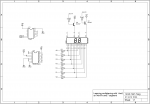nerdegutta
Senior Member
Hi.
I'm trying to learn how to multiplex a 2-digit 7 segment display. Do anyone have any links or, tutorials on this?
This is my schematic, it's on a breadboard - for now...

This is my code:
This is working on one of the digits, but I cannot get my head around, to get the other...
I know I have to
- set pins to output
- set pinsc low
- determin pinsb value
- set digit1 high
- send values to pinsb
- set digit1 low and set digit2 high
- send values to pinsb
- and repeat
First I want to make a counter that counts from 00 to 99.
Anyone?
- nerdegutta
I'm trying to learn how to multiplex a 2-digit 7 segment display. Do anyone have any links or, tutorials on this?
This is my schematic, it's on a breadboard - for now...

This is my code:
Code:
#no_data
symbol lDelay = 200
symbol digit1 = c.0
symbol digit2 = c.1
let dirsb = %111111
main:
high digit1
for b2 = 0 to 9
gosub lookuproutine
inc b0
let pinsb = b1: pause lDelay
if b0 = 9 then
endif
next b2
let b0 = 0
let b2=0
goto main
lookuproutine:
lookup b0,(0,2,4,6,8,10,12,14,16,18), b1
returnI know I have to
- set pins to output
- set pinsc low
- determin pinsb value
- set digit1 high
- send values to pinsb
- set digit1 low and set digit2 high
- send values to pinsb
- and repeat
First I want to make a counter that counts from 00 to 99.
Anyone?
- nerdegutta

